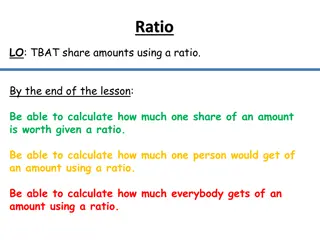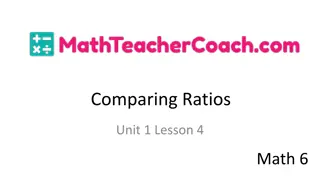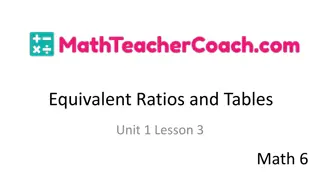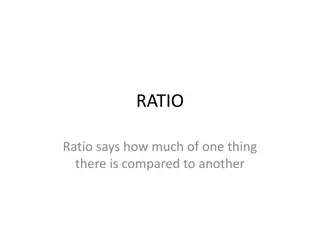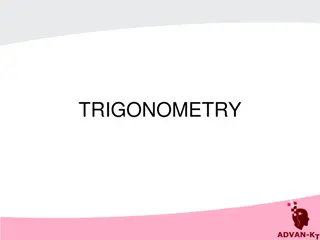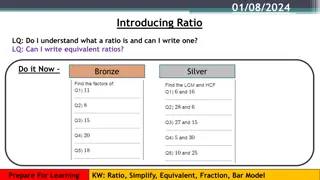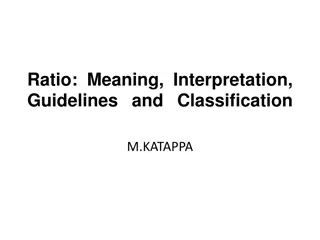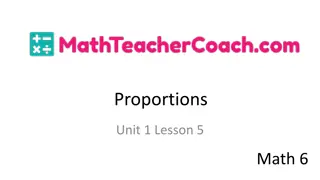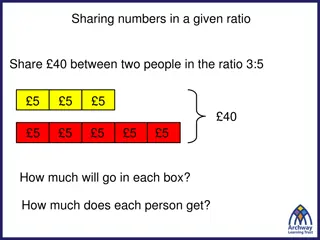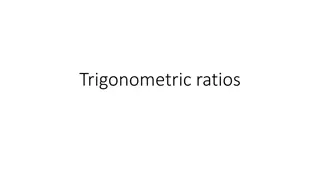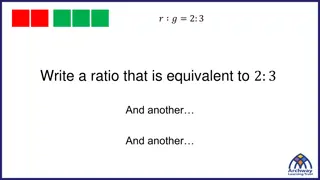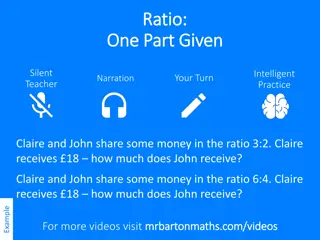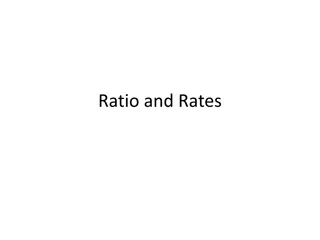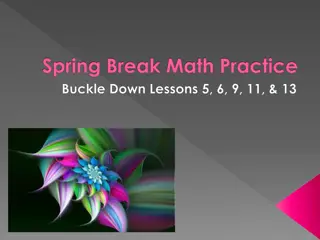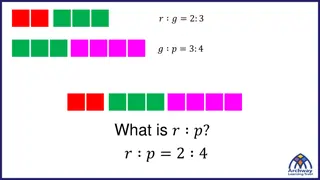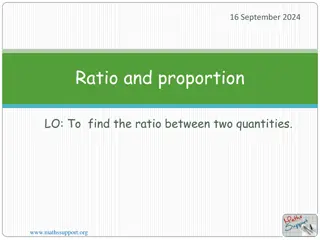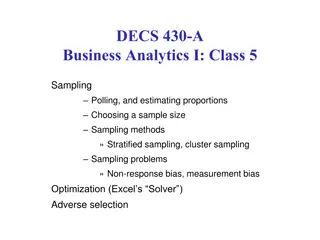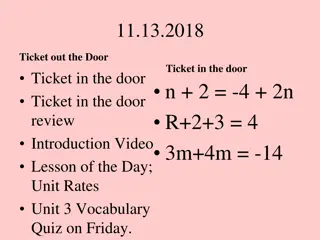Ratios and Proportions
Comparing quantities through ratios, understanding proportions, and applying the unitary method to solve real-life problems are key concepts covered in this chapter. Learn how to find ratios, determine proportions, and solve problems using these mathematical techniques. Explore the importance of expressing quantities in the same unit while forming ratios. Various examples and visuals enhance the learning experience in grasping these fundamental principles.
Uploaded on Mar 10, 2025 | 0 Views
Download Presentation

Please find below an Image/Link to download the presentation.
The content on the website is provided AS IS for your information and personal use only. It may not be sold, licensed, or shared on other websites without obtaining consent from the author.If you encounter any issues during the download, it is possible that the publisher has removed the file from their server.
You are allowed to download the files provided on this website for personal or commercial use, subject to the condition that they are used lawfully. All files are the property of their respective owners.
The content on the website is provided AS IS for your information and personal use only. It may not be sold, licensed, or shared on other websites without obtaining consent from the author.
E N D
Presentation Transcript
TOPIC - RATIOS, PROPORTIONS & UNITARY METHOD
LEARNING OBJECTIVES:- After learning the chapter, student will be able to: (a) understand the concepts of ratio . (b)know how to determine ratio . (c)understand the concepts of proportion . (d)understand how to determine proportion. (e)know how to apply ratio and proportion to solve the real life problems. (f)know how to use the unitary method to solve the problems.
INTRODUCTION Comparing two quantities by division is called ratio. In our day to daily life we compare between so many things, these are nothing but the ratio between them.
A statement of equality of ratios is called proportion. It is nothing but the application part of Ratio. The Unitary method is a technique for solving a problem by first finding a single unit, then finding the necessary value by multiplying the single unit value. This method is very necessary to solve our Daily life problems.
COMPARING OF NUMBERS GROUP-B GROUP-A
5 3 2 (I) BY FINDING DIFFERENCE: GROUP A HAS 2 BOYS MORE THAN GROUP-B VIDEO FOR BETTER UNDERSTANDING OF THE CONCEPT 5 (II) BY DIVIDING NUMBERS: 3 GROUP A IS 5/3 TIMES OF GROUP-B.
RATIOS COMPARING TWO QUANTITIES BY DIVISON IS CALLED RATIO. For Example: There are 5 boys in Group-A and 3 boys in Group-B The ratio of Group-A to Group-B is 5 to 3. -The ratio of 5 to 3 is denoted as 5:3and is read as Five is to Three . -In the ratio 5 is called first term or Antecedent. and 3 is called second term or Consequent.
REPRESENTATION OF RATIO BY DIAGRAM In the above figure, there are total 8 regions out of which 3 are shaded . So the ratio of the shaded region is 3 : 8
The two quantities compared should be expressed in the same unit. For Example: Ratio of 2 m to 75 cm should be 200 cm to 75 cm. The names or units of the two quantities should not be used in Ratio. For Example: Ratio of 200 cm to 75 cm should be 200 : 75. 200 cm : 75 cm
Two quantities which are compared must be in same kind. Different kinds of quantities can not be compared in Ratio. For Example: 10 Rupees and 5 Pens cannot be compared. Ratio should always be expressed in simplest form. For Example: 5 : 10 should be written in the form of 1 : 2.
The order of term in Ratio is important. For Example: If ratio of boys to girls is 2 : 3 then the ratio of girls to boys is 3 : 2.
EXAMPLE:- The ratio of the length of a vertical pole and its shadow on the ground is 7 : 2.Find the length of the pole if the length of the shadow is 2.4m. ANSWER:- Ratio of length of vertical pole and its shadow is 7 : 2. So, the length of pole = 7m Then the length of shadow =2m Now, the length of shadow =2.4 m New Length of pole=7 X (2.4 / 2) =8.4 m
PROPORTIONS A STATEMENT OF EQUALITY OF RATIOS IS CALLED PROPORTION. 4 1 ? 16 4 Are these ratios saying same thing? ?
PROPORTIONS A STATEMENT OF EQUALITY OF RATIOS IS CALLED PROPORTION. It means 1:4 = 4: 16 4 1 Such an equality of ratio is called Proportion. = 16 4 The symbol used to denote proportion is ( : : ) Yes these ratios are saying same thing. i.e. 1: 4 : : 4 : 16 It has been read as 1 is to 4 as 4 is to 16
PROPORTIONS The numbers 1, 4, 4 and 16 are called the terms of the Proportion. 4th Term 3rd Term 1st Term 2nd Term 1 : 4 : : 4 : 16 Means Extremes -Product of means = 4x4=16 -Product of Extremes= 1x16=16 This property helps to check the terms are in proportion. Same
EXAMPLE If a men runs at a speed of 20 km in 2 hours then with the same speed would he be able to cross 40 km in 4 hours. ANSWER: Here the ratio of the distances given is 20/40 = 1/2 =1:2 The ratio of the time taken by them also 2/4=1/2=1:2 Hence, the four numbers are in proportion. We can write them in proportion as 20 : 40 :: 2 : 4 and read as 20 is to 40 as 2 is to 4
EXAMPLE Check the respective terms 30, 99, 20, 66 are in proportion or not. ANSWER: 30 and 66 are extreme terms. 99, 20 are middle terms. These are in proportion if the product of extremes must be equal to product of means. So, 30X66=1980 and 99X20 =1980 So, these terms are in proportion.
CONTINUED PROPORTION:- Three quantities are said to be in continued proportion, if the ratio between the first and the second is equal to the ratio between the second and the third. That is a , b and c are in continued proportion , if a : b = b :c
EXAMPLE:- Check 6, 12 and 24 are in continued proportion or not . ANSWER:- The ratio of first quantity to the second is = 6 : 12= 1 : 2 The ratio of the second quantity to the third quantity = 12 : 24 = 1 : 2 We see that 6 : 12 = 12 : 24 Thus, 6, 12, 24 are in continued proportion .
UNITARY METHOD The unitary method is a technique for solving a problem by first finding the value of a single unit, and then finding the necessary value by multiplying the single unit value. In essence, this method is used to find the value of a unit from the value of a multiple, and hence the value of a multiple.
EXAMPLE If the cost of 3 books is Rs 320 .Then what will be the cost of 6 books. ANSWER: Cost of 3 books = Rs 320 Cost of 1 book =Rs 320/3 Cost of 6 books=Rs 320/3X6=Rs 640. Hence, the cost of 6 books is Rs 640.
ACTIVITIES:- ACTIVITY-1 Take the height of your father and mother, then by using ratio tell that who is taller. ACTIVITY-2 Take the number of pages present in your Mathematics, Science and Social Science books, then tell that the number of pages are proportion or not.
CONCEPT MAPPING UNITARY METHOD RATIO PROPORTION THE VALUE OF SINGLE UNIT COMPARING TWO QUANTITIES BY DIVISON A STATEMENT OF EQUALITY OF RATIOS The numbers are called the terms of the Proportion. The first and fourth term are called Extremes. The second and third terms are called means. The product of means and extremes are always same in a true proportion. Finding the value of a single unit. Then find the value of a multiple. In the ratio first term is called Antecedent and second term is called Consequent. The two quantities compared should be expressed in the same unit. The names or units of the two quantities should not be used in Ratio. Two quantities which are compared must be in same kind. Different kinds of quantities can not be compared in Ratio. Ratio should always be expressed in simplest form. The order of term in Ratio is important.



